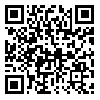Volume 13, Issue 2 (4-2009)
IBJ 2009, 13(2): 65-72 |
Back to browse issues page
Download citation:
BibTeX | RIS | EndNote | Medlars | ProCite | Reference Manager | RefWorks
Send citation to:



BibTeX | RIS | EndNote | Medlars | ProCite | Reference Manager | RefWorks
Send citation to:
Atlasi M A, Mehdizadeh M, Bahadori M H, Joghataei M T. Morphological Identification of Cell Death in Dorsal Root Ganglion Neurons Following Peripheral Nerve injury and repair in adult rat. IBJ 2009; 13 (2) :65-72
URL: http://ibj.pasteur.ac.ir/article-1-59-en.html
URL: http://ibj.pasteur.ac.ir/article-1-59-en.html
Abstract:
Background: Axotomy causes sensory neuronal loss. Reconnection of proximal and distal nerve ends by surgical repair improves neuronal survival. It is important to know the morphology of primary sensory neurons after the surgical repair of their peripheral processes. Methods: Animals (male Wistar rats) were exposed to models of sciatic nerve transection, direct epineurial suture repair of sciatic nerve, autograft repair of sciatic nerve, and sham operated. After 1 and 12 weeks of the surgery, the number of L5 dorsal root ganglion (DRG) and ultrastructure of L4-L5 DRG neurons was evaluated by fluorescence and electron microscopy, respectively. Results: Nerve transection caused sensory neuronal loss and direct epineurial suture but no autograft repair method decreased it. Evaluation of morphology of the neurons showed classic features of apoptosis as well as destructive changes of cytoplasmic organelles such as mitochondria, rough endoplasmic reticulum and Golgi apparatus in primary sensory neurons. These nuclear and cytoplasmic changes in primary sensory neurons were observed after the surgical nerve repair too. Conclusion: The present study implies that the following peripheral nerve transection apoptosis as well as cytoplasmic cell death contributes to neuronal cell death and reconnection of proximal and distal nerve ends dose not prevent these processes.
Type of Study: Full Length/Original Article |
Subject:
Related Fields
| Rights and permissions | |
 |
This work is licensed under a Creative Commons Attribution-NonCommercial 4.0 International License. |








.png)
